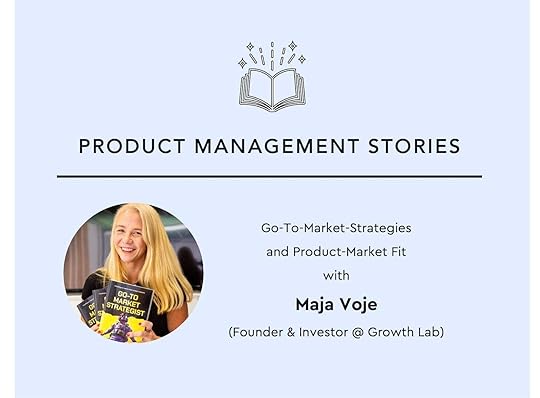Maja Voje's Blog, page 10
January 11, 2024
They might say they love it, but will they pay for it?
Dear GTM Strategist!
You and I both know how very important it is to secure the traction for your innovation.
Thanks for reading GTM Strategist! Subscribe for free to receive new posts and support my work.
More so in 2024:
AI and low-code tools made entry barriers to new entrants to your industry lower than ever.
Investors are getting more demanding and usually require traction.
The buyers hold us against higher standards than ever before.
In my book GTM Strategist, I shared multiple examples of how you can start monetizing before the product is even built, which helps tremendously on our bootstrapping journey. It also prevents us from wasting time and money building products that the markets will not want 🦗 🦗 🦗.
And rest assured, I eat my own dog food, too (figuratively) 🐶
My partner Ognjen Bošković and I validated our cohort GTM Strategist Bootcamp using a Notion page - we are starting in February, 5 spots are still available. You are welcome to apply if you are into B2B GTM (more info below)
What is better is to hear it from you, the readers who translate the lessons from the book to your business success.
Semilla’s case: 60 days, 600 users, 30 paid subscribersThis week’s GTM Strategist Hero is Alexiomar Rodriguez, Founder and CEO of Semilla, which develops 2 products: Seed Academy (music business education for the Latin music industry) and Flou (SaaS solution for legal and music contract management).

I congratulated him on LinkedIn and he provided us with some more insights:
1. Who is the product for ICP?
“We started with music creators (artists and producers). Still, now we are using the Beachhead strategy to focus on the ICP that actually faces the pain: the music entrepreneur (managers, lawyers, labels, and publishers). Mind you, our software is in Spanish.”
2. How did you come up with the idea?
“I'm an entertainment lawyer and have seen both music creators and entrepreneurs struggle with their legal tasks, mainly with contracts.”
3. Which channels did you use?
“We have a music business community and online educational platform called Seed Academy. We used our community (email + IG + YouTube) to drive traffic to our new software.”
I was blown away by how many right decisions were made here.
Alexiomar has a lot of industry experience from his service business. He built something that solved the problem he had seen again and again.
They differentiated themselves from other players by localizing the product to Spanish.
The team leveraged an existing community and had access to the segment. Play on your strengths!
But here is my favorite part: They tested WTP (Willingness to Pay) at launch.
Instead of bragging about thousands of free users who may or not pay,
Alexiomar and his team now know what the current conversion rate to pay is.
This insight will help them tremendously with marketing and sales decisions and be more successful in raising funds if they decide to do so.
As the product will evolve and deliver more value to users, the pricing will change.
And the conversion rate at colder audiences than community will likely be lower from the get-go.
But it is so important they did it.
Bravo, Alexiomar! Here is a GTM Strategist Medal for you:

Let’s dive into why it is important and lucrative to get early signals that the market does the only way they would buy it but also swipes the credit card.
PMF is the king, WTP is the queenTesting Willingness to Pay (WTP) in addition to Product-Market Fit (PMF) has become mission-critical as the competition is rising, entry barriers are lowering, investors are becoming more skeptical and consumers more demanding.
Product development is expensive.
It helps to get some money not only for the company's lifeline but also for team morale.
Fueled by customer insights, the product team has a much better fighting chance and motivation to conquer the market.
But should we do it for free?
I do not think so.
Coming from Europe, where access to seed capital is so-la-la, I was always in a position where we had to dance for our money before whoever took us seriously.
The better I can prove that the product not only has a Product-Market Fit, but also that its business model has sense (confirmed WTP), the better my chances of crossing the chasm are.
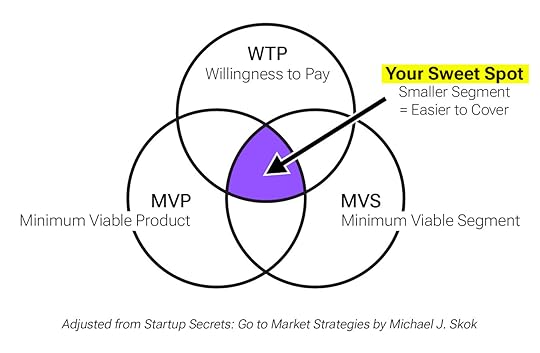 How can we test WTP?
How can we test WTP? Most product managers I know would say to send out a survey, and run customer interviews and focus groups.
Gabor-Granger and Van Westendorp pricing models to the rescue?
I have two concerns:
People may say a lot of things, but their actions don’t always follow.
Most GTM companies are still working on their ICP. The chances of testing on a wrong sample are high for pre-traction companies.
Here is a list of different validation methods that we curated with a product leader dr. Else van der Berg.

Some of you may wonder:
Are you saying we should not be doing interviews and launching crappy MVPs to presell?
Nope.
There is a spectrum and you can use multiple research methods to run these tests.
The more saturated the market is, the better your MVP has to beThe rule of thumb is that the more saturated the market you enter, the more developed your MVP has to be because people have expectations. If the market is very competitive, your product will have to be much more perfected and serve the market 10x better than existing alternatives.
Can you pull it off?
The other solution is to find a proportion of the market that is super unhappy with existing alternatives and build a perfect solution for that vertical.
You may learn that through the interviewing process.
In a recent study done by OpenView and sponsored by Paddle, they found that the best-in-class outlying companies focus on verticals - yes, riches are often in the niches and AI native is the cool new kid in town.
 Your turn:
Your turn:Learn more: If you want to dive deeper into this field, super-experienced product leader and founder Denny Klisch and I recorded this podcast episode that just aired this week. He talks about his experience in testing WTP as well: https://bit.ly/45ylQjC
Share your story: You know how much I love your stories and how proud I am that you are winning in business armed with the insights that we share here. DM me, send me an email, or better yet - tag me in a post like Alexiomar did so I can reshare it.
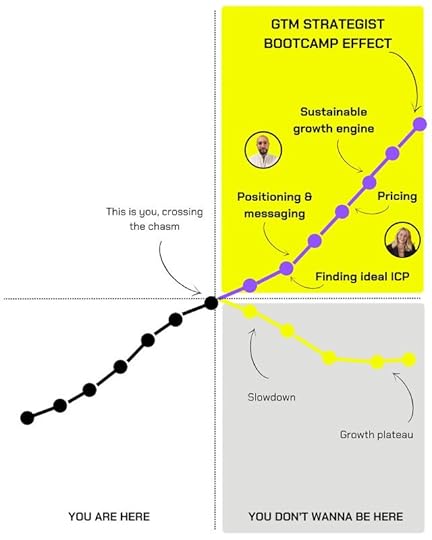
Stop hoping for traction and become a GTM-first builder instead with experts who worked with:

Let’s join forces: https://encouraging-booth-c0f.notion.site/GTM-Strategist-B2B-Bootcamp-1d0d2b52f91447cba4019e11a30af545. We are starting in February, 5 spots are still available. You are welcome to apply if you are into B2B GTM. Ognjen Bošković (3x Head of Growth - inc. CXL Institute) and I will guide you through your GTM journey - we will cover ICP, pricing and packaging, messaging and positioning, and how to create growth machines and loops. Current applicants are all from B2B - founders, product managers and growth experts. Ping me if you are interested. We will make a huge difference in February, which is also my B-day month 😇
Thanks for your time.
I very much appreciate you and wish you a happy go-to-market!
Talk soon,
Maja
Thanks for reading GTM Strategist! Subscribe for free to receive new posts and support my work.
January 4, 2024
Turn Building in Public into your most profitable GTM channel
Hello GTM Strategists!
Welcome to 2024.
Thanks for reading GTM Strategist! Subscribe for free to receive new posts and support my work.
I hope we spent some time together with the GTM Strategist book during the holidays, but even if you took some time off, I hope you relaxed and enjoyed life a little.
Now - back to work!
I have a challenge for you in 2024: build in public.
It can be one of the most lucrative GTM moves this year.
My inspiration for this post was EarthCare.ai, which specializes in helping insurance companies create better policies and pricing using a combination of AI and hyper-local severe weather & climate data.
I have been watching them closely since April, when they joined TechStars in Berlin. They are now raising their pre-seed round (of which 40% is already committed by VCs and angels).
The leadership consists of two technical cofounders, Gorjan and Dragan. They previously worked for Booking.com, WSAudiology, and Mozilla.
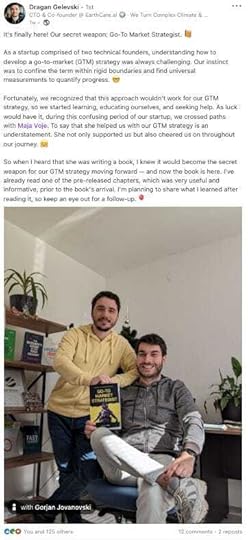
And I love the way how they are building in public on LinkedIn. They provide a really good example.
Wait - what?
How can two developers agree to start posting to LinkedIn, a channel traditionally associated with recruiters asking them silly questions and developers trolling back?
Because they are smart guys.
Dragan said it well during our call this week: “I am a technical founder, but in order to be great in business, I have to learn the business and do something new - whatever will help with our traction.”
I love this mindset.
Smart founders like them know very well that investors, potential clients and partners are going to check them out there before they decide for a discovery call.
They also know that nobody will magically know what they are working on if they do not open up about their progress.
Lastly, they are aware that by building the public, they help other founders and aspiring entrepreneurs to go to market.
If it is so good - why are more people not doing it?
Because it’s cringe.
Building in Public is not the same as Bragging in PublicI am honored to borrow this thought from the co-founder of Lemlist and the author of “The $150M Secret”, Guillaume Moubeche. It is a great book that I am reading at the moment.

LinkedIn does not have to be cringe.
You can curate very well what you see and with whom you interact.
I am quick to unfollow all vanilla content creators, crying CEOs, and other peacocks who communicate metrics that do not even matter in business.
In my perfect world, I consume content to learn something new from it.
Is it worthy of my attention? What is in it for me?
You might be the same.
Who has time to consume other people's business traumas, when everything around is burning and we should deal with it?
I prefer action.
Let’s get you to Build in Public!Not to brag, but to inspire, in December I generated:
reach of 1 million people (vanity metric)
4000 new followers (vanity metric), and
high-quality prospects for business development in January (now we are talking!)
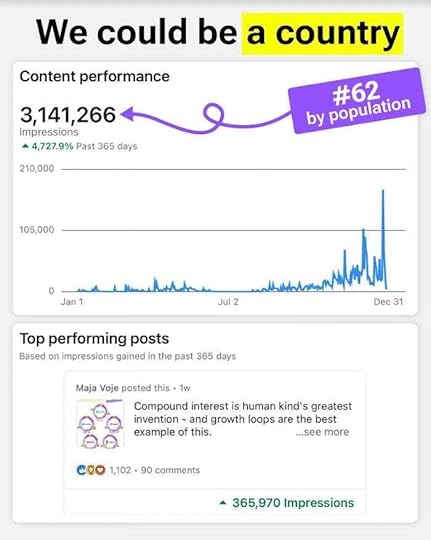
And you can do it too. I believe in you.
Here are the steps that I recommend to my smart, analytical, and critical friends.
This is how you kick off your Building in Public Habit.
Observe:
Start by observing the platform and engaging in comments - just get into a habit of opening up LinkedIn and writing at least one comment first. Do it for 7 days.
Analyze:
I actively seek high-quality content creators that cater to a similar audience (entrepreneurs, product managers, growth experts). I select a couple and do a “competition for attention” analysis). Here are a couple of actions to consider:
Ring the bell on their profiles so that I am engaged
Reward their work with a comment if I like it
Save the post if I find it inspirational for my content creation
Put such posts on my moodboard
Return to their content when I am ready for content creation.
Create a content plan:
The safest place to start is resharing other creators' content with your original take on it. If you are a bit bolder, you can also answer some questions that people are repeatedly asking you or share a framework, some results, or a presentation. But feel free to start small. A list of 10 favorite tools to do X is likely to land very well.
It worked for a Product Leader and GTM Strategist collaborator Sara Stojanovski (2.6K followers). She got 1000 new followers overnight with this one. Algorithms can do wonders sometimes.

Develop your LinkedIn routine:
I usually spend an hour a day on LinkedIn - you can do it for 30 minutes, no problem.
My LinkedIn routine is:
15-20 min: Comment on 10 posts of selected content creators - value comments, not “congrats”.
15-20 min: Publish a post - I have drafts pre-prepared (I write on weekends), but I always tweak them a bit before the final push & I use Taplio for scheduling when I am busy.
Stay around for 20-30 more minutes to engage with the community in comments and DMs.
I know that is not feasible for everyone, but at least try it out by doing it consistently in January and producing 1-3 posts a day. Book a couple of slots and get it done. Try to be consistent with hours; I usually post between 9:00 and 11:00 in my timezone.
You want tools - sure!Here are some tools that will help you get started:
👉 Example of a moodboard of Perfect profiles
👉 Example of a moodboard of LinkedIn posts that inspire me
👉 LinkedIn Optimisation Process
Your turn: What will you publish?What will your next LinkedIn post be?
Did you find a cool new tool?
Got a cool template to share?
What did you learn on the job?
I am sure you have something to show. I very much encourage you to start 2024 strong by publishing your own post.
You can totally tag me in the comments and I will support you.
Fair?
By Building in Public, you will make LinkedIn a better place for people like you and attract new opportunities.
Any other questions - let’s talk!
If you want more, you are welcome to:
Enroll in GTM Bootcamp with Ognjen Bošković that starts in February - he helped me develop a content strategy for the book and led the content machine at the CXL Insititute. He is my go-to buy for demand generation and can help you get to the next level too.
Finally get your copy of the GTM Strategist book on Amazon (starts at $9.99)
If you want to support the GTM Strategist Substack, you are welcome to pledge your bet below.
Have a great start to 2024!
Maja
Thanks for reading GTM Strategist! Subscribe for free to receive new posts and support my work.
December 28, 2023
How to make 2024 your best year ever
Dear GTM friend!
I hope that while you are enjoying your holiday break, you find a moment or two to reflect and strategize on your 2024 endeavors. December is a wonderful time to do that. Nature and business stop for a while, almost as a gift to our busy minds to calm down and re-evaluate our mission.
Every time that entrepreneur wishes another entrepreneur to “take a good rest during the holidays”, I smirk for a second because, for most of us, it is not a switch button.
If you are preparing your GTM strategy, launching new products or services, securing investments, and fighting to win more traction, it is stressful. And you cannot just let go and shift from 100 to zero because there are holidays.
Last week, I was working with Web 3.0 and AI teams in Serbia with Swiss EP. I was mentoring 14 teams, presented at 3 events, and worked from 8 am to 10 pm three days in a row. I wanted to give it everything because these are “my people” and we have a pretty cool science to help on the GTM traction.
What surprised me the most was the number of “lifestyle” topics that teams felt it was important to address at mentorship sessions:
Two co-founders, who are also a couple, probably came for “permission” to scale their already viral social media by hiring another social media manager, which would allow them to focus on product strategy. We also talked about the maker mode and how important it is to protect some time in a day to do undisrupted work.
There was a guy who did not have the “spark” for the idea he presented. I asked him what made him excited about his venture in the first place. He started to talk about some AI networks and how consensus is being made (something super technical). I quickly realized that he was not passionate about selling the product to corporates, and we made peace that it is an intermediate step to secure money so that later on, the team can spend more time working on their product-led business model and build a strong community. At the same time, he can start knowledge sharing now.
Last but not least, one of the teams went a bit bananas. They thought the question “Are you solving a real problem?” was like a cup of baby lions. I love the passion. But if you spend half of the session trying to convince a mentor why your solution is the best instead of asking smart questions, we might have a bit of an ego issue there.
Every growth is you-ledWhat do all these “tales” have in common? On a spectrum from lifestyle to professional conversation, these types of conversation touch the left side of the spectrum.
By now I strongly believe that the company grows as fast and much as you do as an entrepreneur because every growth is founder-led first.
You will have to do the first sales calls.
You will answer the first support tickets.
You will select the first team members.
But we all come with some nervous system deficiencies from being “completely chill” on this journey and some traumas that are hard to process.
Recognizing them is the first step to getting better.
I like to start by externalizing the issue. It is not that “I have a fear of rejection” - the issue is that the fear of rejection is preventing me from sending out more pitching emails. If I find a way to defeat it, my business is probably going to grow faster and better.
Now I can work on it.
I consider myself more of a logical person, so my mental process goes like this.
What is the worst thing that can happen? - I can upset someone, get a “no”, or be ignored.
OK, can you live with it? - Yeah, I think I can.
What is the minimal thing that you can do to break the chain? - Maybe send 50 LinkedIn messages for a start.
Now - what can I do in the next hour/day/week to collect the evidence that I will not die alone, abandoned by my tribe because I sent out 50 emails? - Just freaking send them today!
It is not always easy, and some issues never disappear.
You just get better at dealing with them, and you can eventually turn some into your “pets”. Collect the evidence that whatever they are whispering in your ear is a delusion. Their arguments will slowly fade—exposure therapy rocks.
High five, imposter syndrome - we had an issue with public performance, but we are pushing hard enough. Been there, done that, let’s go!
 Let’s get tactical: Goal-setting & barriers
Let’s get tactical: Goal-setting & barriers It is unreasonable to expect that life will magically get different on the 1st of January 2024.
You will probably have the same or less time than you do now.
New opportunities will emerge, and it will be even harder to prioritize.
You will not change that much as a person in a week either.
This is why you will have to learn to work with what you have.
What is preventing you from reaching your goals right now?
What is your realistic setup in life? How much “more” can you give in without damaging other fields of life that make it worth living?
The right answer is rarely to work harder.
Everybody I know in the GTM space is pretty hard-working anyway.
The key to the solution is probably closer to figuring out what you can let go - outsource, stop doing, or minimize - to make space and bandwidth for new endeavors in your life.
Avoid the temptation of scattering yourself too thin - you can intensively work on 2-3 objectives at the same time. It is OK to only choose one.
In this game of delayed gratification, it will help you tremendously if you set up some sort of milestones of habit-tracking programs to see (and celebrate) intermediate steps.
One workout will not make you ripped.
One LinkedIn post will not make you famous.
One cold email is unlikely to bring a new client in.
But do it 100x and it might happen. Things compound, and we need to create a critical mass.
Here are the two frameworks (free and non-gated) that will help you with goal-setting and habit-tacking:
OKR for GTM that I co-developed with Natalie Nedre (Miro) and Matic Molicnik (Netcetera)
My weekly planner with a habit tracker that I have been using for four years now and it works like a charm for me.

I hope it will help you too, but each human is different.
I have very little tolerance left for lifestyle gurus who want you to meditate for an hour before having a cold shower and having a faux coffee from a plant that grows in Scandinavia and allegedly has superpowers.
You do you.
And get help if you are stuck on the journey.
Let me know if there is anything you need me to support your 2024 endeavors.
But please write your objectives down. 90% of people will not do that, so here you already have an advantage. You are more likely to achieve the objective if it is written down and revised often.
But for now, mission-critical is to celebrate the New Year well, to gather the strengths for your new GTM endeavors, and to say a huge thanks to the people around you who support you on your mission.
Cheers to our new wins in 2024!
Ready for hypergrowth?If you want to start the new year strong, Ognjen Bošković (3x growth lead, ex Growth Lead at CXL, and content boss) and I have prepared a GTM Bootcamp for you. We will cover everything you need to enter hyper growth:
Customer research & finding your ideal target segment
Positioning and messaging
Pricing and packaging
Building a sustainable growth engine
We’ll be your dedicated mentors and advisors for a month (and some more after the live sessions are over), and we’ll ensure you have a strong head start for your 2024 GTM plans.
The price increases in January, so this week is your last chance to get it at early bird pricing.
You can learn all about the program here, and I’m an email away if you have any additional questions. Looking forward to seeing you there!
Thanks for reading GTM Strategist! Subscribe for free to receive new posts and support my work.
December 21, 2023
How to close your first enterprise client
Rule of thumb: in early go-to-market, you should focus on early adopters.
But sometimes, breaking the rules is a great strategy.
What if you could hit the jackpot from the get-go and convince a big name to take your product or service for a spin before winning the hearts and minds of early adopters?
These Moby Dicks will give you the leverage, enormous trust boost and help attract more big clients like them… But you will have to work hard to win their trust and make it worth it for them to trust you.
(just so we’re clear, I refer to all the enterprise companies, strategically important partners and moonshots as - Moby Dicks 🐳)
Selling to enterprise eventually becomes #1 goal for most companies. It's hard (practical guide below), but it's worth it:
🤑 Bigger deal sizes (duh)
💪 Highest NRR (net revenue retention)
🏆 Social proof (mmm, those logos) helps acquisition
NRR especially becomes a game-changer in your company’s growth curve:
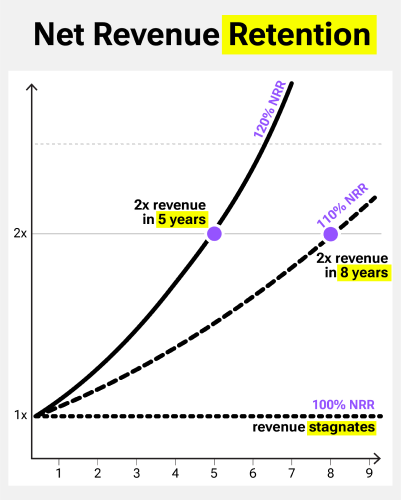
Obviously, it comes with downsides too:
☑️ Looong sales cycles (my personal record is 3 years)
☑️ More meetings than you'd imagine
☑️ Competition (you're not the only one trying to slide into their DMs)
☑️ Compliance (just wait and see)
☑️ Product adjustments (they may ask for additional features)
☑️ Churn risk (if a few of these accounts make up most of your revenue, one leaving is a big hit for your business)
So should you avoid selling to enterprise in early stages of your GTM and settle for SMBs?
'It depends' 😅
As I said, it's so worth it - one enterprise deal can bring enough revenue to your org for the next 1-3 years of runway.
But you can't just 'stumble upon' these deals. You need to make a clear decision and adjust your go-to-market strategy to make this happen.
I generally advise against going after whales, but just in the last two weeks, I had three instances that made me write this piece:
Ange (founder of Add Maple) just closed Greenpeace global as one of their first clients for the data visualization and analysis tool - she is recording custom onboarding videos for them on their own data sets and going through great lengths of making this happen.
Joanna Bunker (a partnership manager at Wings, Alphabet company), a contributor to my GTM Strategist book, told me they’re proud to be in business with a startup and really appreciate their service level. They first learned about the startup through cold outreach.
Senita Slipac and her awesome team (whom I mentor via Swiss Entrepreneurship program) and her marketplace Orea just set up a partnership with Visa, which is a huge credibility and adoption booster for the marketplace.
(all ladies this time - that makes me very proud!)
There’s no secret formula. If you have a great product and are willing to work extra hard and smart, you can do it too.
I was also invited to mentor seven Web 3.0 teams at Attic42 accelerator and I was working on a slide deck about how early ‘big brands’ traction was pivotal to the success of OriginTrail that I was working with back in 2017-2019.
The founders were genius in partnership building and creating PoCs (proof of concepts) with big brands. We partnered up with GSI, Oracle, BSI and multiple other big brands. It was a game changer in terms of our credibility and traction.
Yes, the odds might be stacked against you, but if you have cutting-edge technology, if you’re willing to go an extra mile and you actually have something that:
- saves costs
- creates more profit
- or ideally both
…then it’s 100% possible.
(In early GTM, aim to be 10x better than established competitors)
It’s very important that you don’t just rely on this one bet. But if you succeed and land a big contract, your growth curve can easily exponential.
Let’s Get TacticalHere are a few tips on how to win an enterprise deal with your Moby Dick:
✅ Proximity
Many corporates have accelerator programs for startups. Every now and then, they adopt new tech innovations from their accelerators.
✅ Partnerships and marketplaces
Many technology vendors have marketplaces where you can publish your solutions. Becoming their select “use case” is a big prize - they celebrate those with marketing and PR budgets.
✅ Magnetism
Become the person their key decision makers like. Build your personal brand on LinkedIn, invite them to podcasts, share unique insights, speak their language.
✅ Old school
Yup, trade shows, networking events, interviews and good old professional associations. CEO may not be there, but you can surely meet some managers or VPs that will help you understand what it takes to get there and how decisions are made. Maybe they will even endorse for you.
✅ Product-led
Give before you take. There may be silent enterprise users in your ecosystem already. They might have accounts with their private emails addresses to avoid the risk of being “attacked by sales” or internal compliance. Identify them and start building trust. Make sure you communicate that your enterprise packages exist.
Now go and win your first enterprise client!
PS. If you want to learn more (in fact, everything you need to know to reach product-market fit), check out GTM Strategist, my 6x Amazon bestselling book.
GTM Strategist Bootcamp
If you enjoy the real talk - no fluff that we have in this newsletter, you might be a great fit for the GTM Strategist Bootcamp.
This is a training for those of you who want to master go-to-market strategy, solidify your market position, and get ready for hyper growth. You can learn more here:
Ognjen Bošković (3x Growth Lead, ex CXL) and I created a GTM program for ambitious founders and product managers that gets you ready to truly start scaling. If you can relate to this, this training is for you:
You’ve built a great product and now you want to create significant traction around it
Your next goal is to enter the hyper growth phase and you want to ensure success
You understand that main growth levers of a business are product and distribution, and you want to become an expert in distribution as well
The era of build it and they will come is over and you know it.
You know that in order to win in B2B in 2024 and beyond, you need to become GTM-first, distribution-first builder. We will make sure you do.
I have tested this program with over 70 teams this year and it works like a charm. During the program, we’ll work on:
Week 1: Target market selection
Week 2: Positioning and messaging
Week 3: Pricing and business model
Week 4: Building a predictable growth engine
It’s limited to 30 seats, and we start in January. There’s also a huge early bird discount if you secure your seat before December 25th.
Thanks for reading GTM Strategist! Subscribe for free to receive new posts and support my work.
December 14, 2023
True character shows when sh** hits the fan
Your product is genius. The market would have to be stupid to reject the offer.
And yet, that still happens.
Here’s a real story from the trenches:
I was working with a team last week, and they worked like crazy.
It was intense. They did everything by the book, and still, the market “did not get it”.
400 people in the pipeline - zero sales. Why?
Is it December, and should we just relaunch in January?
Did anyone complain about the offer and the price?
Maybe they needed to understand more benefits - what’s in it for them?
Their plan was to outwork their way to product market fit. So I had to put a hard stop on the project because that never works.
The solution is never to do more, but to go back to the basics.
If the early signals during your launch are not looking good, you most likely have:
A product problem
A target segment problem
Always go back to this PMF cycle visual and find where you are in it:
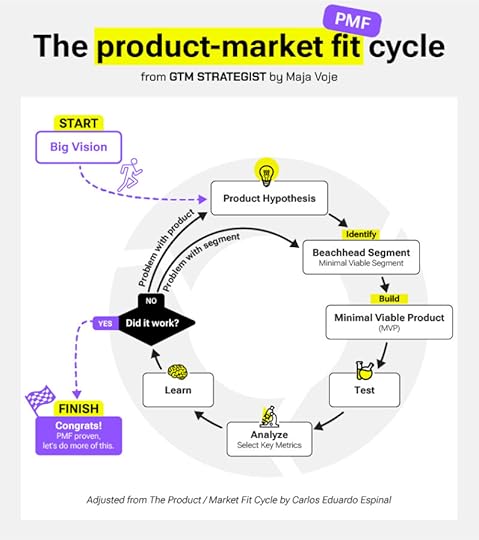
You’ll be tempted into thinking that you have a:
Pricing problem (too expensive!)
Tactic problem (our copy could be better!)
Channel problem (we should try Facebook ads instead!)
But most of the time, you’re suffering from the product or customer problem.
So stop looking at this superficially and stop trying to outwork your way to PMF. Instead, go back to the drawing board and figure out which one of these two problems you have and start building a new hypothesis that will fix it.
Now, this is a headache for most GTM team and founders - it kills your spirit to not see success with the first launch. But, market is harsh and go-to-market isn’t for the weak.
You’re not weak. Your best friend on this journey isn’t excessive funding, great ideas, expensive consultants…
It’s resilience. It is one of the most important yet undervalued characteristics in business.
In the words of the wonderful Chumbawamba band:
I get knocked down, but I get up again!
Oftentimes time you just have to (wo)man up and do what is mission-critical in order to get there. No one is cheering for you (in fact, a lot of them are against you), rubbing your shoulders and saying that you got this.
No one but yourself can gather the strength to create the critical level of evidence that you got this. This is it. You are in it to win it.
Stop relying on external gratification and take the manners into your own hands. No one but you can make this happen.
Your business can only grow as much as you do as a person and a leader.
Let’s get tactical: Decision-making unitB2B hill I'm willing to die on: personas are bullshit. Here's another reason why:
Most of the time, you're not dealing with a persona, but a decision-making unit (DMU).
It's really hard to think of an exception, isn't it?
If you are selling a complex, expensive and hard-to-onboard product/service that requires multiple stakeholders in a company to buy, implement and use...
You are most likely selling to DMU, which consists of:
✅ Initiator: first thinks of a purchase
✅ Influencer: influences decision
✅ Gatekeeper: can say no to the decision
✅ Decider: actually decides what to buy
✅ Buyer: actually makes a purchase
✅ User: uses or consumes the purchase

This is how DMU looks like in practise. But why should you care?
B2B selling is hard because your GTM efforts needs to speak and sell to this whole group.
You need different USPs, messaging and marketing materials for different members for DMU members.
If you do not understand their interests, concerns and constrains - game over.
No matter how much the end-user loves your product, if you don't get buy-in from the DMU, that sweet big account that you are chasing is off the table.
The solution (as always) is to know your customer(s) as much as possible:
▶️ Interview your customers and ask them to describe the buying process
▶️ Ask existing customers to send you info on how they chose you
▶️ Offer a workshop or webinar about your technology/service and see who shows up
▶️ Find out from prospects what else do they need to support internal decision making and who participates in this decision
Customer insights ftw. Who is in your decision making unit?

If you enjoy the real talk - no fluff that we have in this newsletter, you might be a great fit for the GTM Strategist Bootcamp.
This is a training for those of you who want to master go-to-market strategy, solidify your market position, and get ready for hyper growth. You can learn more here:
Ognjen Bošković (3x Growth Lead, ex CXL) and I created a GTM program for ambitious founders and product managers that gets you ready to truly start scaling. If you can relate to this, this training is for you:
You’ve built a great product and now you want to create significant traction around it
Your next goal is to enter the hyper growth phase and you want to ensure success
You understand that main growth levers of a business are product and distribution, and you want to become an expert in distribution as well
The era of build it and they will come is over and you know it.
You know that in order to win in B2B in 2024 and beyond, you need to become GTM-first, distribution-first builder. We will make sure you do.
I have tested this program with over 70 teams this year and it works like a charm. During the program, we’ll work on:
Week 1: Target market selection
Week 2: Positioning and messaging
Week 3: Pricing and business model
Week 4: Building a predictable growth engine
It’s limited to 30 seats, and we start in January. There’s also a huge early bird discount if you secure your seat before December 25th.
Thanks for reading GTM Strategist! Subscribe for free to receive new posts and support my work.
December 7, 2023
No more growth hacks please
Never put the word growth hacking in your pitch deck.
It is not a dirty word, but it is very unlikely that investors will say shut up and take my money.
Last week I was working on a pitch with one of my teams that are seeking for an international investment ATM and their Go-To-Market slide looked promising:
Priority #1: Content marketing & SEO (50% of activities)
Priority #2: LinkedIn and X thought leadership (20% of activities)
Priority #3: Cold outbound (10% of activities)
Until I have seen …
Priority #4: Growth hacking (20% of activities)
Wait, what?
You mean experimentation? Building growth loops or product-led growth?
What on earth is growth hacking doing in your pitch deck?
There are no silver bulletsDon’t get me wrong. I like experimentation. I love moonshots.
I am also a co-instructor of the best-selling Growth Hacking course on Udemy.
But working with trusted investors to try to create a GTM Fund (one of the most important goals for 2024) made me realize that this will make them tick for the wrong reason.
Why?
On the GTM slide of your pitch deck investors seek for the following sanity checks:
Do you have a healthy understanding of a market and customers?
Do you have a game plan on how to win a significant market share in 3-12 months?
Do you have a fighting chance to use these “channels” better than competitors?
Do you have skills and capacity to master those channels?
Does the CAC/LTV math compute- when will they see their money back with interest?
Investors like predictable revenue generating systems - your ability to generate profit at predictable and growing rates. And so your job in GTM is to find 2-3 of those systems that will reliably drive growth.
Growth hacking, experimentation, call it whatever you want - the goal of these activities is just to find these predictable growth engines.
7 Proven GTM Growth StrategiesFor an e-commerce brand, it would be fairly easy to describe go-to-market strategy.
First, we will do some UGC (user generated content) and engage influencers, push these materials out with Meta and TikTok ads and then do some remarketing and email marketing. I said easy to describe, not do :)
In B2B, things get a bit more complicated.
The issue with many startups is they jump straight into tactics: let's launch on Product Hunt, collect some emails, do LinkedIn, use Ai... Before defining their strategy.
I'm not the one to propose endless strategy discussions you'll never execute on, but the reality is, you need both. As Sun Tzu famously said:
Strategy without tactics is the slowest route to victory. Tactics without strategy is the noise before defeat.
Tactics alone won't get you anywhere. Before you get to them, follow this process:
strategy > channel > tactic
Never think about growth as 'random acts of marketing', but motions. Each comes with specific unit economics, different sales cycles, some are better at generating demand and some at capturing demand.
So, start with choosing a GTM motion first. In my experience, there are seven different proven GTM Growth Strategies worth considering as a backbone to your GTM growth model:
Inbound: Content creation with the intent to generate leads.
Paid digital: Media buying to attract the attention of your target audience.
Outbound: Cold outreach to companies that match your target audience via email, social media, telephone, or direct mail.
Account-based marketing (ABM): A strategic approach where sales and marketing teams work together to target and engage specific high-value accounts with personalized campaigns. The focus is on individual accounts rather than a broad audience.
Community: Creating valuable content and engaging members of a community.
Partners: Agreement with a compatible company to join marketing and sales efforts for mutual benefit.
Product-led growth (PLG): Development of a solution (usually a SaaS product) in a way that a prospect can self-onboard and get value before monetization efforts begin.

Most companies will find 1-3 GTM growth motions that will bring them 80% of business.
You select them based on:
customer insights
competitive landscape & opportunities
your internal expertise & capacities
unit economics
Now back to growth hacking. Or let’s agree we’ll call it experimentation.
Sean Ellis suggests that we leave 10% - 20% of resources aside for these endeavors and I agree.
Invest the rest toward initiatives that will predictably and reliably drive growth.
GTM Strategist Bootcamp
If you want to master go-to-market strategy, solidify your market position, and get ready for hyper growth, I have some good news. Learn more here:
Ognjen Bošković (3x Growth Lead, ex CXL) and I created a GTM program for ambitious founders and product managers that gets you ready to truly start scaling. If you can relate to this, this training is for you:
You’ve built a great product and now you want to create significant traction around it
Your next goal is to enter the hyper growth phase and you want to ensure success
You understand that main growth levers of a business are product and distribution, and you want to become an expert in distribution as well
The era of build it and they will come is over and you know it.
You know that in order to win in B2B in 2024 and beyond, you need to become GTM-first, distribution-first builder. We will make sure you do.
I have tested this program with over 70 teams this year and it works like a charm. During the program, we’ll work on:
Week 1: Target market selection
Week 2: Positioning and messaging
Week 3: Pricing and business model
Week 4: Building a predictable growth engine
It’s limited to 30 seats, and we start in January. There’s also a huge early bird discount if you secure your seat before December 25th.
Thanks for reading GTM Strategist! Subscribe for free to receive new posts and support my work.
November 30, 2023
No 2024 GTM Strategy yet?
Hey GTM Strategist!
This is my first Substack post, and we’ll kick it off with a strong topic - building your strategy for 2024.
It’s December and by now you should have 2024 planned out. But if you don’t… believe me, you’re not alone.
I literally just got a very concerned email from one of the founders that I will be working with next weekend through one of my favorite partners, The Swiss Entrepreneurship Program (Swiss EP), and the email reads as follows:
“We are launching a new version of the platform this Friday and I am embarrassed to tell you that we still have not set up the GTM Strategy for 2024.”
My response:
“The launch is a tunnel vision. We will do everything that is mission-critical to get there. But it is a great time to do it in early December, to have a firm plan of what is a priority in January, and to hop on the business train as soon as possible.”

We finally agreed that at our session next week, we would reverse engineer her objective to generate €75,000 Monthly Recurring Revenue (MRR) and adjust the tactics later.
I really felt her struggle and inconvenience.
During the launch of my recently published book, GTM Strategist, I experienced the same struggle.

We were firefighting and troubleshooting Amazon issues, the content creation process, and negotiating like lions when the design outline would be finished.
My go-to answer when someone asked me what my vision with the book is
“To help 10,000 businesses to cross the chasm”.
How to get there - just a blurry idea.
I was not in the right mindset to work on a strategy and firefighting the launch simultaneously.
People were DM-ing me that they could not retrieve the Kindle version, there was a cover pilling off of one of the test prints and I had 4 podcasts recordings scheduled for the week.
But if you only work on urgent things, and not the important high-impact things, you can miserably fail as a leader.

I had to fix it asap, suck it up and present the team with a strategy.
This is what helped me switch from “launch firefighting” to the GTM strategy mode again post-launch in 3 days.
Here are five steps that will get you in the GTM Strategy mindset in December:
Take some distance. Tell the team you are off for at least ½ day or better a day to just “let it go”. Start the “strategy day” with something that you actually like. A dog walk, a workout, some reading, let your eyes enjoy some daylight first.
Expand. Create a moodboard of competitors and inspirational companies and study some of their selected tactics. Avoid copying them directly. The best strategy is proprietary but you will get some inspo and open your mind with this step.
Set up an objective. You probably already have it in mind. If you need to structure it better, there is an OKR framework for GTM in the Book.
How could you get there? Well that is the fun part! You can either do this alone first and later on with the team as well, but since you are the leader of the operation and will take responsibility for the success. I would not just go in the room and say - mission critical is to sell 2000 yearly subscriptions - how can we do that??? Shoot. I’d present my case better and prepare the ground first.
What is the best way to get there? You know how it is- you can do anything, but you cannot do everything. Choose your battles. Create a simple plan, which is realistic and will most likely get you there. There always are dependencies. Prioritize like a boss! Overcommitting and having FOMO is the key to failure. You have to be sharp.
 Your turn.
Your turn. Set some time aside. Create a calendar slot where you can think in peace and quiet in December right now. There will always be something, which is more urgent. But setting up your plans for 2024 is important.
Explore GTM Strategist Templates that we recommend from Miroverse. The awesome team from Miroverse kindly gathered them in a special section 🙌
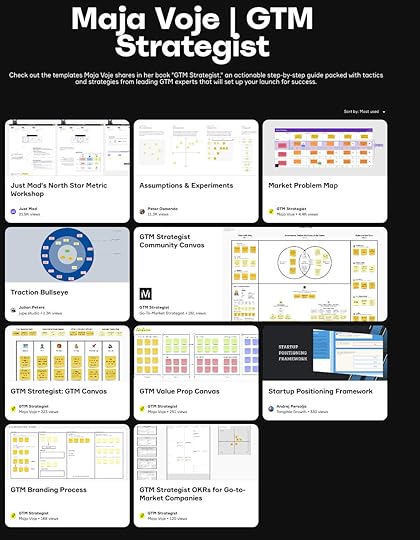 Need some help with your GTM strategy?
Need some help with your GTM strategy?Let me know what you think and we will discuss if I can help you out.
And if you haven’t done it already, you can order GTM Strategist here.
It will become your compass on your strategizing journey in December.
Thanks for reading GTM Strategist! Subscribe for free to receive new posts and support my work.

